Related Research Articles

Claude Vivier was a Canadian contemporary composer, pianist and ethnomusicologist of Québécois origin. After studying with Karlheinz Stockhausen in Cologne, Vivier became an innovative member of the "German Feedback" movement, a subset of what is now known as spectral music. He was also among the first composers in either Europe or the Americas to integrate elements of Balinese music and gamelan in his compositions, alongside Lou Harrison and fellow Quebecker Colin McPhee.
André Prévost, was a Canadian composer and music educator. He was awarded the Canadian Music Council Medal in 1977 and in 1985 he was made an Officer of the Order of Canada. He also received the "Trophy for Concert Music" from the Performing Rights Organization of Canada.
Bob Gilmore was a musicologist, educator and keyboard player.

Yoritsune Matsudaira was a Japanese composer of contemporary classical music.

The Fred Frith Guitar Quartet was an American-based contemporary classical and experimental music guitar quartet comprising Fred Frith, René Lussier, Nick Didkovsky and Mark Stewart. The group was formed in 1989 by Frith and they performed extensively across North America and Europe for the next ten years, including at the 14th Festival International de Musique Actuelle de Victoriaville in Victoriaville, Quebec, Canada in May 1997. They recorded their first album, Ayaya Moses in 1996, and released a live album, Upbeat in 1999.
Stefans Grové was a South African composer. Before his death the following assessment was made of him: "He is regarded by many as Africa's greatest living composer, possesses one of the most distinctive compositional voices of our time".

Krzysztof Meyer is a Polish composer, pianist, and music scholar, formerly Dean of the Department of Music Theory (1972–1975) at the State College of Music, and president of the Union of Polish Composers (1985–1989). Meyer served as professor of composition at the Hochschule für Musik in Cologne from 1987 to 2008, prior to his retirement.

Elie Robert Schmitz was a Franco-American pianist and composer.

Anne Louise Brillon de Jouy was a French musician and composer. Born in Paris, she lived in Passy and played and composed for the harpsichord and the piano. She learned to play the harpsichord as a child.
Zarrina Mirshakar is a Tajik composer. She was born in Dushanbe, Tajikistan, into the family of the national poet Mirsaid Mirshakar. She studied at Dushanbe Music College under Yuri Ter-Osipov from 1963–67 and at the Moscow Conservatory with Sergey Balasanian from 1967–74.
George Herbert Fryer was an English pianist, teacher and composer.
Kenneth Kwaku Avotri Kafui was a Ghanaian composer. He was a lecturer in music theory and composition at the music department of the University of Ghana, Legon. He was also the Director of Abibigromma Theatre Group of the University of Ghana. Born into a musical family, he was considered one of the leading composers of his generation in Ghana, in African art music. He composed choral works, works for choir and orchestra, symphonic works, piano and organ works, and works for traditional African instruments. He created new concepts and genres in African art music such as the Pentanata, the HD-3 form and Drumnata.
John Borstlap is a Dutch composer and author on cultural subjects related to music and the visual arts. His work is rooted in German musical traditions and he is a proponent of a revival of tonal and classical traditions.
Jean-Claude Pennetier is a French classical pianist.
Shiraz is a virtuosic piano piece by Claude Vivier, written in 1977. It is named after the eponymous Iranian city, and contains a flurry of interlocking rhythmic combinations and pulses at great speed. Vivier was inspired to write the piece after listening to blind singers perform in the city's market square. He wrote in the piece's program notes how he found Shiraz to be, "a pearl of a city, a diamond vigorously cut."
Lonely Child is a piece for soprano and orchestra by Claude Vivier, written in 1980. It is arguably his most well-known piece, and is considered a hallmark composition in the genre of spectral music.
Trois airs pour un opéra imaginaire is a 1982 chamber piece for small orchestra and soprano by Claude Vivier.
Orion is a 1979 orchestral suite by Claude Vivier, named after the constellation of the same name.
Wo bist du Licht! is a is a 1981 piece for mixed orchestra, mezzo-soprano and tape by Claude Vivier.
Kopernikus is an opera in two acts by Canadian composer Claude Vivier.
References
Citations
- 1 2 Lankenau et al. (2012), p. 37.
- ↑ Gilmore (2014), p. 183.
- ↑ Gilmore (2014), p. 184.
Sources
- Gilmore, Bob (2014). Claude Vivier: A Composer's Life. University of Rochester Press. ISBN 978-1-58046-841-1.
- Lankenau, Steven; Chan, Trudy; Gewirtz, Eric (2012). Vivier Works: Claude Vivier (PDF). Boosey and Hawkes.